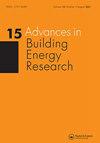CFD-based response surface methodology for rapid thermal simulation and optimal design of data centers
IF 2.5
Q2 CONSTRUCTION & BUILDING TECHNOLOGY
引用次数: 8
Abstract
ABSTRACT In the design of large-scale data centres, CFD is used widely but very time-consuming with intensive computational resource requirement. When it comes to near real-time thermal control or optimizing multiple design parameters of data centres, this method becomes impractical. In this paper, response surface methodology (RSM) based on radial basis function (RBF) is used to significantly reduce the running time while maintaining a good accuracy. In the first application, by using 5%, 10%, and 20% of the original CFD data, the temperature profiles of the three corresponding cases are reconstructed based on RSM. Three reconstructed temperature profiles are then compared to the full temperature profile of a data centre model. The method shows good agreement with the CFD simulation result, especially for the case of 20% utilization of the original CFD data points. In the later application, RSM is used for generating a large set of generations during a two-objective optimization process which uses the genetic algorithm as its main engine. With three investigated design parameters including mass flow inlet, inlet temperature, and server heat load, the goal is to minimize both the temperature difference and the maximum temperature inside the data centre. The outcome shows a desirable range of design input parameters for a data centre. Highlights Response surface model is trained using high fidelity CFD simulation data Radial basis function is found to show superior advantages in constructing response surface Rapid thermal profile reconstruction for data centre using response surface method is illustrated CFD-based response surface method for data centre optimization process is investigated基于cfd的数据中心快速热模拟与优化设计响应面方法
在大型数据中心的设计中,CFD应用广泛,但计算时间长,计算资源消耗大。当涉及到接近实时的热控制或优化数据中心的多个设计参数时,这种方法变得不切实际。本文采用基于径向基函数(RBF)的响应面法(RSM),在保持较好精度的同时显著缩短了运行时间。在第一个应用中,分别使用5%、10%和20%的原始CFD数据,基于RSM重构了三种相应工况的温度分布。然后将三个重建的温度曲线与数据中心模型的完整温度曲线进行比较。该方法与CFD模拟结果吻合较好,特别是在原始CFD数据点利用率为20%的情况下。在后面的应用中,RSM用于在以遗传算法为主要引擎的双目标优化过程中生成大的代集。研究了三个设计参数,包括质量流量入口、入口温度和服务器热负荷,目标是最小化数据中心内部的温差和最高温度。结果显示了数据中心设计输入参数的理想范围。利用高保真CFD仿真数据对响应面模型进行训练,发现径向基函数在构建响应面中具有优势,说明了利用响应面方法快速重建数据中心热剖面的方法,研究了基于CFD的响应面方法在数据中心优化过程中的应用
本文章由计算机程序翻译,如有差异,请以英文原文为准。
求助全文
约1分钟内获得全文
求助全文
来源期刊

Advances in Building Energy Research
CONSTRUCTION & BUILDING TECHNOLOGY-
CiteScore
4.80
自引率
5.00%
发文量
11
 求助内容:
求助内容: 应助结果提醒方式:
应助结果提醒方式:


